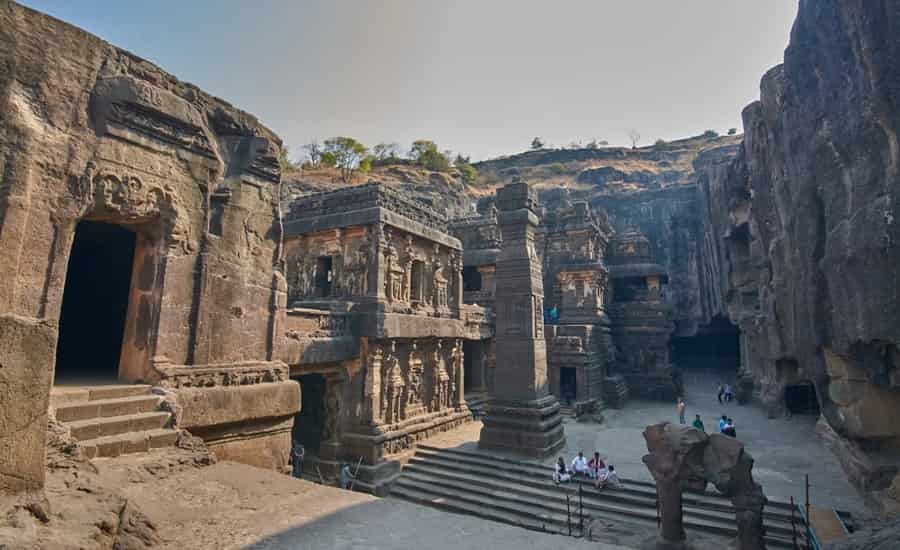Ellora Caves in Maharashtra show the deep cultural and religious history of ancient India. These caves, found in the Charanandri Hills near Ellora village, are a stunning mix of Hindu, Jain and Buddhist rock-cut art. They were built between the 6th and 10th centuries. These caves are famous for their beautiful carvings, amazing statues and different religious influences.

Importance and History
- These caves attract and inspire many from researchers and historians to those who love art.
- Inside carvings and statues not only tell spiritual stories but also show how people lived.
- It shows how people used to dress, how their lifestyle was and how art changed over time.
- We can learn a lot about old Indian architecture from the Ellora Caves.
- Made from a single rock, the Kailash Temple is an amazing example of how smart and talented ancient builders were.
Historical Context
Early Period (6th – 8th Century)
- The Ellora Caves were built sometime between the 6th and 10th centuries.
- The work on the caves probably started under the Hindu Kalachuri dynasty during the 6th–7th century.
- In the first 12 caves, you can see where Buddhist monks stayed and prayed.
Golden Age (8th – 10th Century)
- The Rashtrakuta dynasty was at its strongest when King Krishna and his son Dhruva ruled.
- Both Hindu and Jain artists worked at Ellora during this time and created a mix of art and religious ideas.
- The Jain caves at Ellora (Caves 30–34) were made in the 9th–10th century and show stone art of Tirthankaras like Mahavira.
Architectural Styles
Hindu Caves
- The Hindu caves at Ellora (mainly Caves 13 to 29) are dedicated to different gods, especially Lord Shiva (like in Cave 16, the Kailasa Temple) and Lord Vishnu (like in Cave 15, Dashavatara). Caves 30 to 34 are Jain caves and are dedicated to spiritual teachers called Tirthankaras.
- Each cave has its own unique design and tells stories through its stone work.
- Cave 16, known as the Kailasa Temple, is the most unique. It was made from top to bottom from a single rock.
- This temple is like Mount Kailash, where Lord Shiva is believed to live. Inside, you will see beautiful carvings that show scenes from Hindu stories.
Buddhist Caves
The Buddhist caves at Ellora, built during the Kalachuri and Rashtrakuta times, include prayer halls, monasteries, and Stupas. Cave 10, called Vishwakarma Cave, is known for its beautiful carvings. Some caves, like Cave 5, have large halls with Stupas inside.
Jain Caves
The Jain caves at Ellora show the strong Jain culture of that time. Cave 32, called Indra Sabha, is known for its wonderful artwork and Jain stories.
Challenges and Conservation Efforts
- Ellora Caves are special, but they are getting damaged because of too many visitors, changing weather, and the slow breaking down of the rock walls.
- More and more people are visiting Ellora, which shows how popular the place is, but it also brings challenges in taking care of the caves.
- ASI is working hard to care for the caves by setting up covers, barriers, and other things to keep them safe.
Rediscovery and Conservation
Ellora Caves were hidden for a long time until a British officer found them in 1819. Later, ASI worked to protect them, and in 1983, they became a UNESCO World Heritage Site.
Conclusion
Ellora Caves are one of the best examples of India’s deep spiritual and artistic history. These caves, made directly into rock, were created between the 6th and 10th centuries and show a peaceful mix of Hindu, Buddhist, and Jain traditions. Ellora welcomes visitors to see old temples, peaceful prayer spaces and detailed carvings that tell stories from past. The popular Kailasa Temple cut from single rock and dedicated to Lord Shiva is truly amazing. This special site is looked after carefully so people in the future can enjoy it too. Even today Ellora is place where ancient art, deep faith and India’s history can be felt all in one visit.
Also Read:

 Call
Call WhatsApp
WhatsApp Enquiry
Enquiry